
The Lamiaceae or Labiatae are a family of flowering plants commonly known as the mint, deadnettle or sage family. Many of the plants are aromatic in all parts and include widely used culinary herbs like basil, mint, rosemary, sage, savory, marjoram, oregano, hyssop, thyme, lavender, and perilla, as well as other medicinal herbs such as catnip, salvia, bee balm, wild dagga, and oriental motherwort. Some species are shrubs, trees, or, rarely, vines. Many members of the family are widely cultivated, not only for their aromatic qualities, but also their ease of cultivation, since they are readily propagated by stem cuttings. Besides those grown for their edible leaves, some are grown for decorative foliage. Others are grown for seed, such as Salvia hispanica (chia), or for their edible tubers, such as Plectranthus edulis, Plectranthus esculentus, Plectranthus rotundifolius, and Stachys affinis. Many are also grown ornamentally, notably coleus, Plectranthus, and many Salvia species and hybrids.
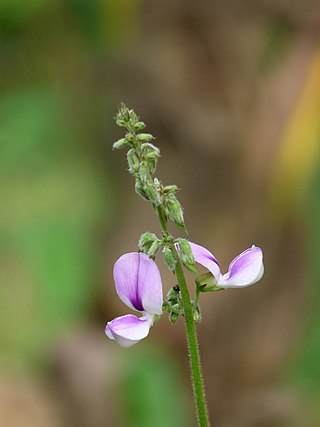
Pueraria is a genus of 15–20 species of legumes native to south, east, and southeast Asia and to New Guinea and northern Australia. The best known member is kudzu, also called Japanese arrowroot. The genus is named after 19th century Swiss botanist Marc Nicolas Puerari.

Vitex is a genus of flowering plants in the sage family Lamiaceae. It has about 250 species. Common names include chaste tree or chastetree, traditionally referring to V. agnus-castus, but often applied to other species, as well.

Alepidea peduncularis is an edible perennial herb native to the montane grasslands of East and South Africa.

Ternstroemia is a genus of flowering plants in the family Pentaphylacaceae. It is distributed in tropical and subtropical regions in Africa, Asia, and the Americas.

Vitex negundo, commonly known as the Chinese chaste tree, five-leaved chaste tree, or horseshoe vitex, or nisinda is a large aromatic shrub with quadrangular, densely whitish, tomentose branchlets. It is widely used in folk medicine, particularly in South and Southeast Asia.

Vitex pinnata is a tree of the family Lamiaceae. It is native to south and south east Asia. It grows slowly, ultimately reaching 20 metres in height with 1–3 m. circumference trunk. It features a grey-brown-yellow bark. Its leaves are scented.
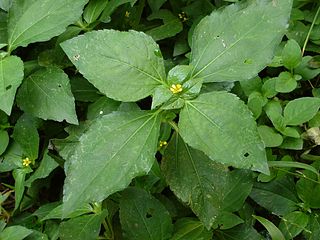
Synedrella is a genus of flowering plants in the family Asteraceae.

Ratibida is a genus of North American plants in the tribe Heliantheae within the family Asteraceae. Members of the genus are commonly known as prairie coneflowers or mexican-hat.

Vitex rotundifolia, the roundleaf chastetree or beach vitex, is a species of flowering plant in the sage family Lamiaceae. It is native to seashores throughout the Pacific. Its range includes continents and islands stretching from India east to Hawaii and from Korea south to Australia. This shrub typically grows approximately 1 m in height. It has a sprawling growth habit and produces runners that root regularly at nodes. This rooting pattern allows the plant to spread rapidly. At maturity, V. rotundifolia produces blue-purple flowers that are borne in clusters and ultimately yield small brown-black fruits. Its leaves are rounded at the tips with green upper surfaces and silver lower surfaces. While the plant is a seashore obligate, it grows over a wide latitude range. It has been used for medicinal purposes throughout its native range. More recently, it was imported to the eastern United States where it has become a seashore invasive. Control efforts are presently underway to protect the fragile beach dune ecosystem.
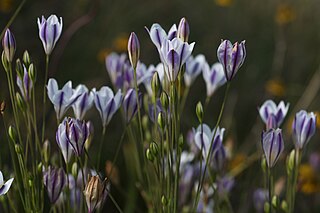
Triteleia peduncularis is a monocot flowering plant in the genus Triteleia. Its common names include long-ray brodiaea and longray triteleia. It is endemic to California, where it occurs in the coastal and inland mountain ranges of the northern and central sections of the state. It grows in vernally moist habitat such as meadows, grassland, and vernal pools, often in areas with serpentine soils. It is a perennial wildflower growing from a corm. There are two or three basal leaves measuring up to 40 cm (16 in) long and 1.5 cm (0.6 in) wide. The inflorescence arises on a smooth, erect stem up to 80 cm (31 in) tall. It is an umbel-like cluster of several flowers which are borne on very long, straight pedicels measuring up to 18 cm (7.1 in) long. Each funnel-shaped flower is white, often tinged purple, with six tepals up to 1.6 cm (0.6 in) in length. There are six stamens with white anthers, and the ovary at the center is yellow when the flower is young.
Vitex divaricata is a tree shrub of the Caribbean native to Puerto Rico and the US Virgin Islands. Its Spanish vernacular names include higüerillo and higuerillo. Its English vernacular name is white fiddlewood. It belongs to the order Lamiales. This tree is common in the Toro Negro State Forest.

Gagea peduncularis is a Mediterranean plant species in the lily family. It is native to Italy (Apulia), Greece, the Balkans, Turkey, Cyprus, and Libya.
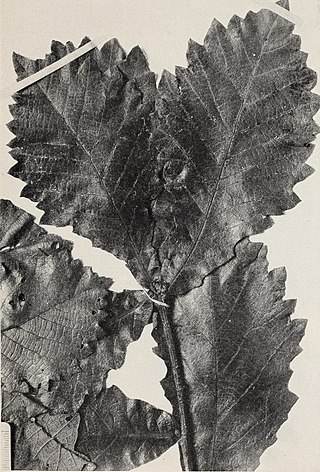
Quercus peduncularis is an oak native to Mexico and Central America, ranging from Jalisco to Honduras.
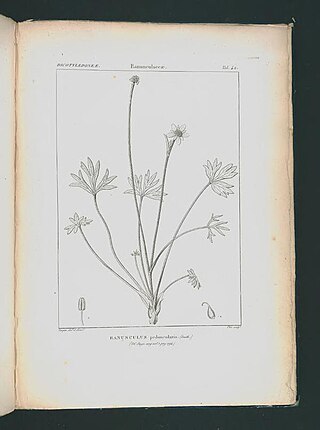
Ranunculus peduncularis is a large perennial buttercup that grows in Patagonia on the margins of woods, scrubs and along streams, with long stems and deeply divided leaves. In the wild it flowers from spring to summer.

Pileanthus peduncularis, commonly known as coppercups, is a plant species of the family Myrtaceae endemic to Western Australia.
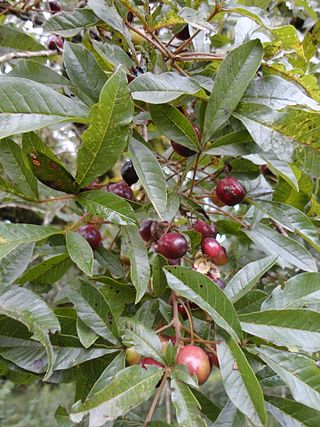
Vitex megapotamica is a hardwood fruit tree found in Argentina, Paraguay, Uruguay, and southern Brazil. In Brazil it is commonly called tarumã.

Crassula peduncularis, commonly known as purple stonecrop, is a herb in the family Crassulaceae.
Khadim Nagar National Park is a major national park and nature reserve in Bangladesh. The park is located at Sylhet Sadar Upazila, Sylhet District in the North-East region of the country. It is located mainly on the Hills and is surrounded by Kalagool, Bhurjan and Goolni tea estates. Khadim Nagar National Park covers approximately 679 ha (6.79 km2) of evergreen forests Biome. The British colonial people cleared the land for extensive tea plantations. After 1950 tree plantations of teak, Garjan, Bamboo, Champa, Agar, Akashmoni, Eucalyptus and Acacia Mangium was carried out by Forest Department. The Forest was declared as national park by the Bangladesh government on 13 April 2006 under the Bangladesh wildlife (Preservation) Amendment Act of 1947. The present forest is divided into 6 forest working circles. The forest area has LR plantations- 380 Ha, SR Plantations-10 Ha, Bamboo Plantations-150Ha, Cane plantations-258Ha and Agar Plantations-40ha.
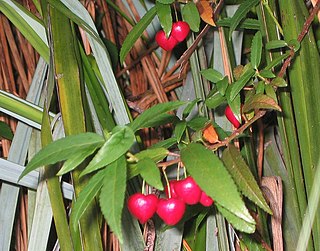
Aristotelia peduncularis, also known as heartberry, is a shrub in the family Elaeocarpaceae, endemic to the wet forests of Tasmania

















